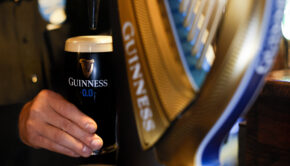Noonan must nurture economic recovery in the budget

With Ireland’s economy finally beginning to show some signs of improvement, Dan White outlines how the government needs to limit its austerity measures if it wants to secure any prospect of enabling this fledgling growth to continue
14 October 2013
Michael’s Noonan’s third budget, due to be delivered on 15 October, has the potential to either further encourage the nascent economic recovery or to stifle it at birth.
As this government reaches the half-way mark in its five-year term the economic news, previously unremittingly bad, has begun to improve. True, the second-quarter GDP and GNP figures, which were published by the CSO on September 19, were pretty pedestrian. While the Irish economy has now officially emerged from recession, GDP grew by just 0.4% between April and June while GNP, arguably a much more accurate barometer of our underlying performance, actually shrank by a further 0.4% over the same period.
So is it all doom and gloom as we face into the seventh austerity budget in the space of just five years?
Worst may be over
Not necessarily. While the second quarter GDP and GNP statistics were anaemic at best, there are strong indications that the worst may be over for the Irish economy.
The first strong signal that things were going seriously wrong with the Irish economy was the collapse in employment levels. The number of people at work in Ireland peaked at 2.146 million in the third quarter of 2007. This had fallen by 321,000 or 15% to just 1.825 million by the first quarter of 2012.
This sharp fall in employment had serious knock-on effects which were felt throughout the economy. Not only did tax revenues fall and social welfare spending rise, the fear of joining the dole queues spread throughout the economy, even to those who kept their jobs. This fear of unemployment probably contributed even more to the collapse in consumer confidence than the property price crash.
Decline in retail sales
Whatever the precise cause for plummeting consumer confidence, what is indisputable is that the value of retail sales fell by over a quarter in the six years to mid-2013. This in turn fed through into lower levels of VAT and excise duty revenues for the exchequer and several high-profile retail collapses, including the Superquinn receivership in July 2011. Since 2007 an estimated 50,000 retail workers have lost their jobs, which in turn has further depressed the government’s take from PAYE and other taxes.
That’s the bad news. The good news is that since about the middle of 2012 the Irish economy has been showing clear signs of recovery. The clearest sign that things are getting better has been the resumption in employment growth with the number of people increasing by 14,000 in the second quarter of 2013 and by a cumulative 45,000 over the past five quarters.
Brighter jobs outlook
However, despite the resumption of employment growth from the spring of 2012, the improved jobs outlook failed to feed through into the broader economy. The economy remained in recession, consumer confidence remained at very low levels and, after a brief rally in mid-2012, the value of retail sales started falling once again from November 2012 onwards.
We seemed to be experiencing the reverse of the situation that existed in the early 1990s, when despite apparently strong economic growth there was no increase in employment – so-called "jobless growth" – with one of significant jobs growth but little or no economic growth.
More positive signs
While it has yet to be reflected in the growth statistics, renewed job creation isn’t the only sign that the economy has turned the corner. Consumer confidence recovered to a six-year high in September and, after having fallen for the previous eight months, retail sales recovered strongly in July and August. The value of retail sales rose by 4.5% in July and by 1.1% in August.
A further indication that the economy is on the mend was provided by the purchasing managers’ index for the services sector, which recorded its 14th consecutive monthly increase in September. Oh, and Dublin property prices are also up, admittedly on tiny volumes, with a 10.6% average price increase being recorded in the 12 months to August.
Some problems persist
Of course huge problems remain, not least the truly appalling level of mortgage arrears and the possibility that the banks will require even more capital, on top of the $64bn which they have already received, from the taxpayer.
While we would be wise not to succumb to premature euphoria, it is clear that, after five years of constant bad news, things have at least stopped getting worse for the Irish economy. Jobs numbers are up, unemployment is down, confidence is rising and the public finances are finally under some sort of control.
The end-September exchequer returns showed that while tax revenues for the first nine months of the year were bang on target, public spending was running slightly under budget. This means that the government should comfortably meet its full-year target of a budget deficit equivalent of 7.5% of GDP.
Choices on the cards
The improved economic and fiscal outlook gives Michael Noonan something he lacked when he was framing his first two budgets – choices. While the overall shape of the 2014 budget will still be largely determined by the 5.1% budget deficit agreed with the troika, the Finance Minister is no longer tied to the €3.1bn budget deficit figure. While Labour is unlikely to get all of the €600m reduction in the 2014 budget deficit it has been seeking, don’t be surprised if Michael Noonan meets it half-way, say €2.8bn-€2.9bn.
So what should Michael Noonan be aiming for when he gets up to deliver his budget speech on 15 October?
Under-estimating austerity impact
We now know courtesy of the IMF that it and other international bodies, including the ECB and EU, massively under-estimated the impact of austerity on the peripheral Eurozone economies. Instead of reducing economic activity by 50 cent, every euro of tax increases and spending cuts knocked a euro or even more off the value of economic activity meaning that austerity, far from helping matters, made an already bad situation even worse.
So Michael Noonan should strive to ensure that, whatever he does in his budget, he doesn’t compound this error. He should do whatever he can to encourage our emerging economic revival rather than making the sort of mistakes that will push the Irish economy back into recession.



 Print
Print






Fans 0
Followers